Don’t worry; we’ve got you covered! In this comprehensive guide, we’ll explore the common reasons behind this issue and provide practical solutions to fix it.
From clogged drain systems to malfunctioning components, we’ll delve into every aspect of refrigerator drain pan problems. Get ready to say goodbye to that pesky water buildup!
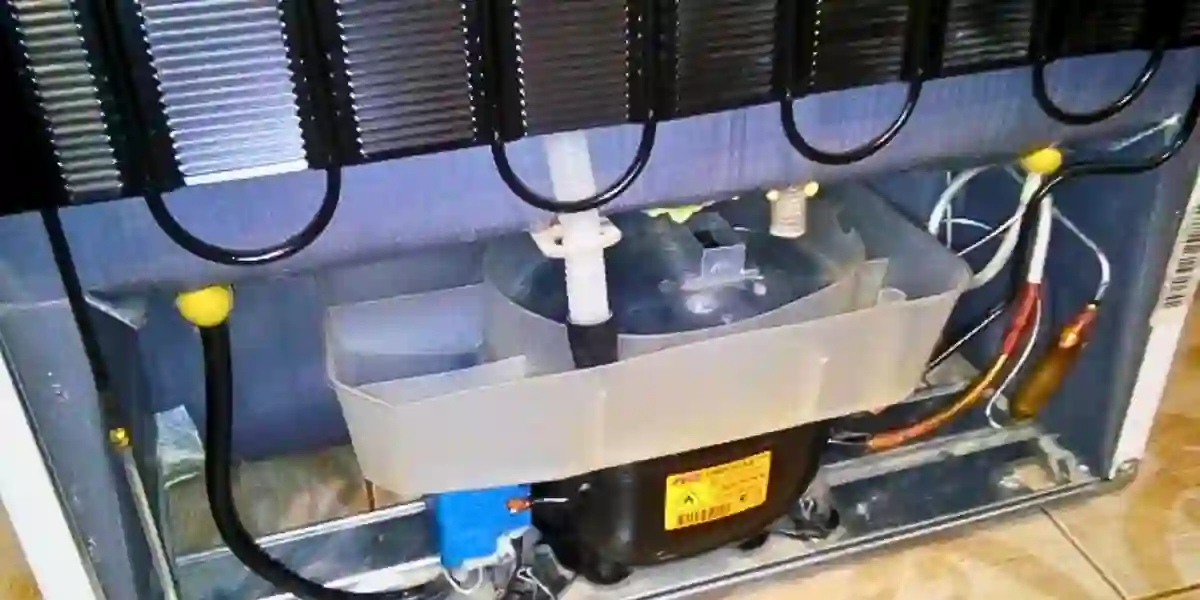
Why Is My Refrigerator Drain Pan Filling Up with Water?
Blocked Drain System
A blocked drain system in your refrigerator can lead to water accumulation in the drain pan. This happens when dirt or debris clogs the drain, preventing water from the freezer’s defrost cycle from draining properly.
As a result, the water collects in the drain pan, causing potential overflow issues. To avoid this, it’s essential to regularly inspect and clean the drain system to ensure proper water flow and prevent any blockages.
You can do this by gently removing any debris or dirt from the drain opening and using a mixture of water and vinegar to clean the drain.
Faulty Ice Maker
A common cause of excess water in the drain pan is a faulty ice maker. When the ice maker’s water valve malfunctions, it can result in extra water dripping into the drain pan instead of going to the ice tray.
To address this, always inspect the water valve for any signs of damage or leakage. If you notice any issues, consider replacing the water valve or seek professional repair.
Incorrect Leveling
Improper leveling of your refrigerator can lead to drainage problems. If your fridge is not slightly tilted back, the water may not drain correctly into the pan, and instead, it could overflow.
To fix this issue, adjust the fridge’s feet or rollers to ensure it is at the right angle for proper drainage.
You can use a spirit level to check if the refrigerator is level and make necessary adjustments.
Damaged Door Gasket
A worn-out door gasket can create gaps in the refrigerator’s sealing, allowing warm air to enter.
This increased temperature difference inside the fridge leads to more condensation, resulting in more water ending up in the drain pan.
Regularly inspect the door gasket for any signs of wear or damage, and replace it promptly if needed.
Cracked Drain Pan
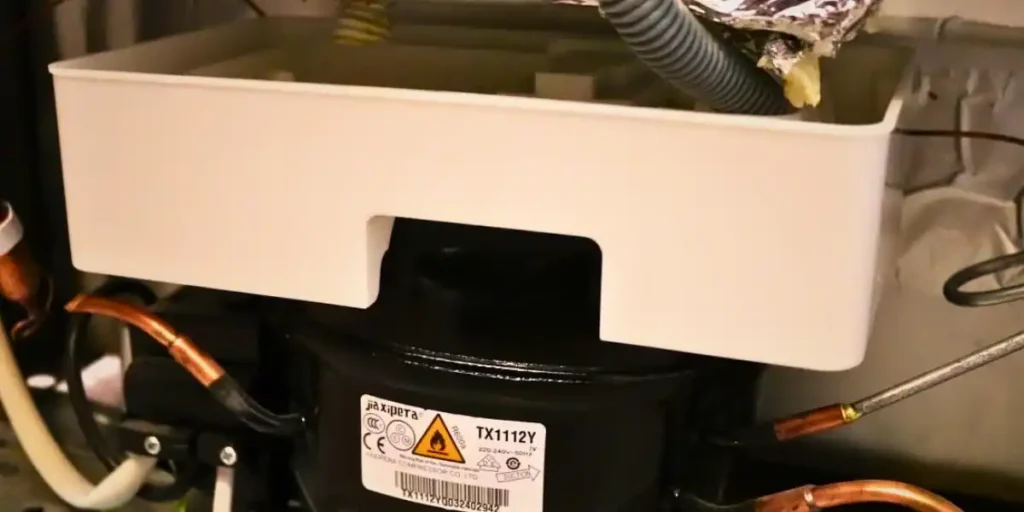
A cracked drain pan can be another source of leaks in the refrigerator. Over time, the plastic drain pan may develop cracks due to wear or temperature changes.
It is essential to inspect the pan regularly for any visible damage and replace it if you find cracks or holes.
This will prevent water from seeping out of the pan and causing potential damage to your kitchen floor.
Poor Refrigerator Location
The location of your refrigerator can impact its performance and contribute to excess water in the drain pan.
Placing the fridge near a heat source like a stove or direct sunlight forces the refrigerator to work harder to maintain the desired temperature.
As a result, it generates more condensation, leading to increased water accumulation in the drain pan.
To avoid this, position your refrigerator away from heat sources and ensure proper ventilation around the appliance.
Incorrect Temperature Settings
Setting the fridge or freezer at a temperature too low can lead to more ice production. When the appliance goes through its defrost cycle, this excess ice melts, resulting in more water entering the drain pan.
Make sure to set the refrigerator at the recommended temperature for optimal performance and to minimize ice buildup.
Malfunctioning Defrost Heater
If the defrost heater in your refrigerator is malfunctioning, it can cause excessive ice buildup in the freezer.
When the ice melts during the defrost cycle, it overwhelms the drain pan. To address this issue, check the defrost heater regularly for any signs of malfunction, and if necessary, seek professional assistance to repair or replace it.
Aged Appliance
As a refrigerator ages, it may encounter challenges in maintaining a consistent temperature. This leads to more condensation inside the appliance, filling up the drain pan.
Regularly monitor and maintain your older refrigerator to prevent issues related to temperature regulation and water accumulation.
Excessive Door Opening
Frequent opening of the refrigerator door allows warm air from the surrounding environment to enter.
This increases the condensation inside the fridge, leading to more water collecting in the drain pan.
To minimize this, avoid unnecessary door openings and make sure to close the door properly each time.
How to Fix a Full Refrigerator Drain Pan?
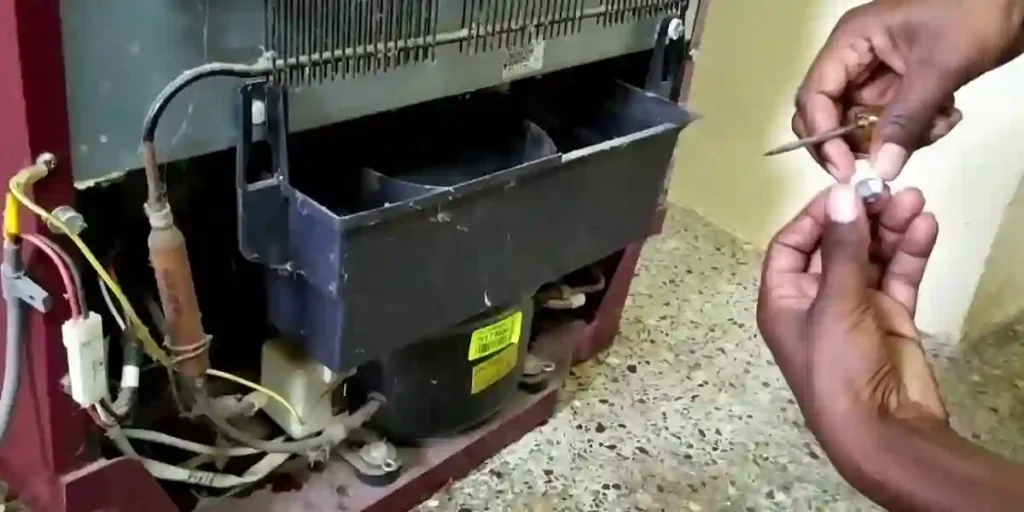
Step 1: Inspect the Drain System
To start fixing the issue of a full refrigerator drain pan, begin by closely inspecting the drain system.
Check for any signs of dirt or debris that might be obstructing the drain. When the drain system is clogged, water from the freezer’s defrost cycle cannot flow freely, leading to water accumulation in the drain pan.
Take a moment to carefully examine the drain opening and surrounding area for any blockages.
Step 2: Clean the Drain
Once you’ve identified any blockages, it’s time to clean the drain properly. Gently remove any dirt, debris, or ice that might be causing the clog.
To ensure a thorough cleaning, use a mixture of equal parts water and vinegar. This natural solution is safe for your refrigerator and can help dissolve any build-up that may have occurred over time.
After cleaning, check if water flows smoothly through the drain.
Step 3: Check the Ice Maker
A malfunctioning ice maker can contribute to excessive water in the drain pan. Inspect the ice maker and its components, paying special attention to the water valve.
This valve controls the flow of water into the ice maker’s tray. Any issues with the valve can result in water leaking into the drain pan instead of being used for ice production.
Step 4: Fix Water Valve Issues
If you find any problems with the water valve during your inspection, it’s crucial to address them promptly.
Depending on the issue’s severity, you may need to repair or replace the water valve to prevent further water overflow in the drain pan.
This step ensures that water intended for ice-making is directed correctly and reduces the strain on the drain system.
Step 5: Adjust Fridge Level
A simple yet essential step in fixing a full refrigerator drain pan is ensuring that the appliance is correctly leveled.
If your fridge isn’t tilted back slightly, water may not drain correctly into the pan, causing potential overflow issues.
Use a spirit level to check the fridge’s level and adjust its feet or rollers as needed to achieve the proper tilt.
Step 6: Examine Door Gasket
The door gasket is a critical component in maintaining the refrigerator’s internal temperature. Inspect the door gasket thoroughly for any signs of wear or damage.
A worn-out gasket can lead to warm air entering the refrigerator, causing increased condensation and subsequently more water ending up in the drain pan.
Step 7: Replace Door Gasket
If you find any issues with the door gasket, it’s essential to take action immediately. Replace the worn-out gasket to ensure a proper seal and prevent further water leakage.
A well-functioning door gasket helps maintain the fridge’s temperature and reduces excess condensation, easing the burden on the drain system.
Step 8: Inspect the Drain Pan
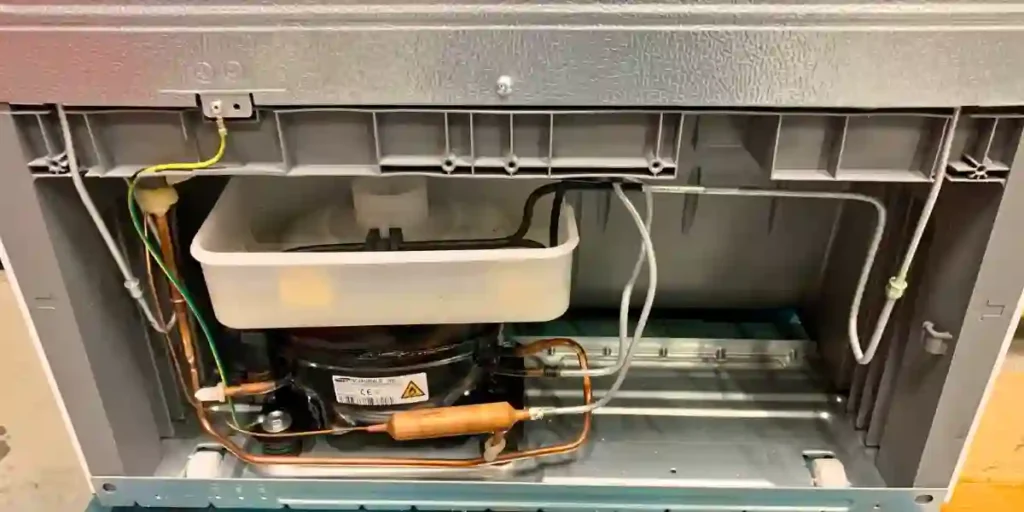
Moving on, it’s time to focus on the plastic drain pan located at the bottom of the refrigerator.
Carefully examine the pan for any visible cracks or holes. Cracks can cause water to leak out of the pan and onto your kitchen floor, leading to potential damage.
Step 9: Replace the Drain Pan
If you find any damage to the drain pan during the inspection, don’t delay in taking action. Replace the damaged drain pan with a new one to ensure proper containment of water.
This replacement prevents any water from escaping the pan, keeping your refrigerator’s surrounding area dry and safe.
Step 10: Reposition the Refrigerator
Consider the location of your refrigerator in your kitchen. If it’s placed near heat sources like a stove or in direct sunlight, the fridge has to work harder to maintain its internal temperature.
This increased workload can lead to more condensation and water accumulation in the drain pan. Reposition the refrigerator away from heat sources to alleviate this issue.
Step 11: Check Temperature Settings
Temperature settings play a crucial role in refrigerator operation. Verify that the fridge and freezer are set at the recommended temperature for optimal performance.
If the temperature is set too low, the fridge can produce more ice than necessary. When this excess ice defrosts, it results in more water in the drain pan.
Step 12: Inspect the Defrost Heater
The defrost heater is responsible for preventing excessive ice buildup in the freezer. Regularly check this component to ensure it is functioning correctly.
A malfunctioning defrost heater can lead to more ice accumulation and, subsequently, an overflow in the drain pan.
Step 13: Repair or Replace Defrost Heater
If you detect any issues with the defrost heater during your inspection, don’t hesitate to take action. Repair or replace the defrost heater to ensure proper functioning.
Addressing this problem promptly can prevent water overflow in the drain pan and maintain the fridge’s optimal performance.
Step 14: Monitor Aging Appliances
For those with older refrigerators, it’s crucial to monitor and maintain their performance regularly.
Older appliances may struggle to regulate temperature, resulting in more condensation and water filling up the drain pan. Regular maintenance can help identify and address potential issues.
Step 15: Minimize Door Openings
Lastly, reduce the frequency of opening the refrigerator door to avoid warm air from entering the fridge.
Frequent door openings contribute to increased condensation inside the fridge, leading to more water accumulating in the drain pan.
Make a conscious effort to open the fridge door only when necessary and close it properly each time.
By following these detailed steps, you can effectively fix a full refrigerator drain pan and ensure the proper functioning of your appliance.
Regular maintenance and attention to these crucial aspects can keep your refrigerator running smoothly and prevent potential issues in the future.
How to Prevent Water Spilling Over the Refrigerator Drain Pan?
Preventing water spillage over the refrigerator drain pan is essential to avoid potential damage and inconvenience.
Here are some straightforward yet effective steps you can take to keep your drain pan clear and functioning properly:
1. Level Your Refrigerator:
Ensure your refrigerator is correctly leveled to prevent water from overflowing the drain pan. When a refrigerator is not level, water may not flow properly into the drain pan, leading to water accumulation inside the fridge.
Use a spirit level to check the fridge’s tilt from front to back and side to side. If it’s not level, adjust the front legs until the refrigerator sits evenly on the floor.
2. Clean the Drain System Regularly:
Regular maintenance is key to preventing clogs in the refrigerator’s drain system. Over time, food debris, dirt, and other particles can accumulate and block the drain tube, leading to water backup.
To keep the drain clear, inspect and clean it every few months. Remove any debris or obstructions you find and flush the drain with a mixture of water and mild detergent to ensure it’s free from any build-up.
3. Keep the Fridge Interior Clean:
Maintaining a clean and tidy fridge interior is essential to minimize excess moisture and condensation.
Wipe up any spills or leaks immediately to prevent water from seeping into the drain system.
Avoid leaving uncovered liquids inside the fridge, as they can evaporate and increase the humidity levels, leading to more water accumulation.
4. Check the Door Gasket:
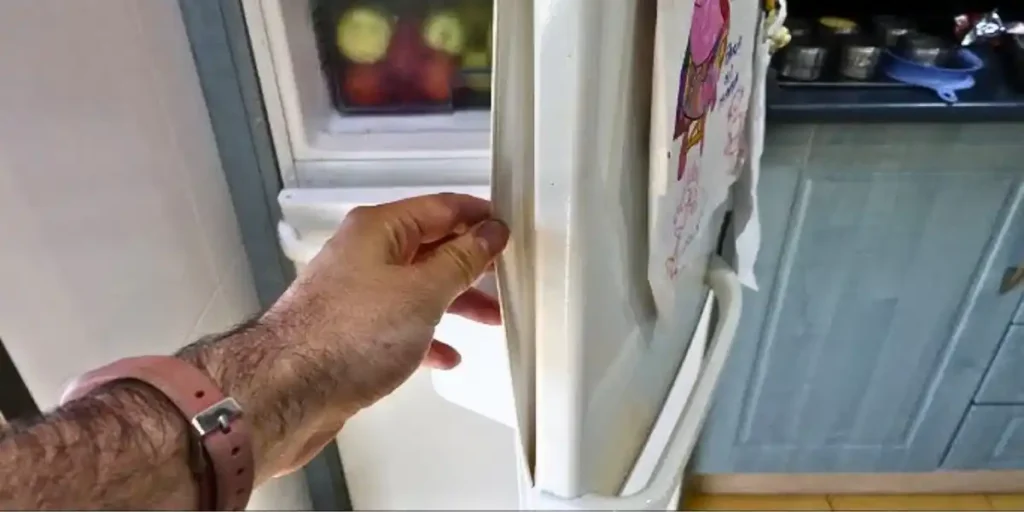
The door gasket is a critical component that forms a tight seal around the fridge door. A worn-out or damaged gasket can compromise the seal, allowing warm air to enter the fridge.
This temperature difference can cause condensation, leading to more water in the drain pan.
Regularly inspect the gasket for any signs of wear, tears, or cracks. If you notice any issues, replace the gasket promptly to maintain an airtight seal.
5. Monitor Humidity Levels:
High humidity can contribute to increased condensation inside the fridge, which can result in a fuller drain pan.
Consider using a dehumidifier in your home, especially during humid weather, to reduce excess moisture.
By maintaining proper humidity levels, you can help minimize condensation and water accumulation in the drain pan.
6. Avoid Overfilling the Fridge:
Proper organization inside the fridge is crucial to ensure adequate air circulation. When a refrigerator is overloaded with items, the airflow can be disrupted, leading to uneven cooling and increased condensation.
To prevent this, avoid overfilling the fridge and allow space between items for proper ventilation.
7. Check for Cracks in the Drain Pan:
The drain pan is responsible for collecting excess water and condensation from the fridge.
Over time, the pan may develop cracks or damage, causing water to leak out. Regularly inspect the drain pan for any signs of wear or cracks.
If you find any issues, replace the drain pan promptly to maintain its proper function.
FAQs about Refrigerator Drain Pan Issues
Can a cracked drain pan cause water leakage?
A cracked drain pan can indeed be a source of water leakage. The pan is designed to collect condensation and excess water, so if it has cracks, the water can escape and accumulate beneath the fridge.
How often should I clean the refrigerator drain system?
For optimal performance, it’s recommended to clean the refrigerator drain system at least once every six months.
However, if you notice any signs of clogging or water buildup, it’s best to clean it more frequently.
Can high humidity in the air affect the refrigerator drain pan?
Yes, high humidity can lead to increased condensation inside the fridge, resulting in more water in the drain pan.
To minimize this, consider using a dehumidifier or reducing the humidity in your home.
Is it normal for the drain pan to be filled with water occasionally?
Occasional water in the drain pan is normal, especially during hot and humid weather.
However, if you notice constant water accumulation, it’s essential to investigate and address the issue.
Conclusion
Dealing with a refrigerator drain pan filling up with water can be frustrating, but armed with the right knowledge, you can resolve the issue quickly.
We explored the common causes behind a full drain pan, from clogged drain systems to faulty components.
By following our troubleshooting tips and preventative measures, you can keep your refrigerator in excellent working condition and say goodbye to that pesky water buildup.
Remember to perform regular maintenance and cleaning to ensure the optimal performance of your refrigerator’s drain system.
